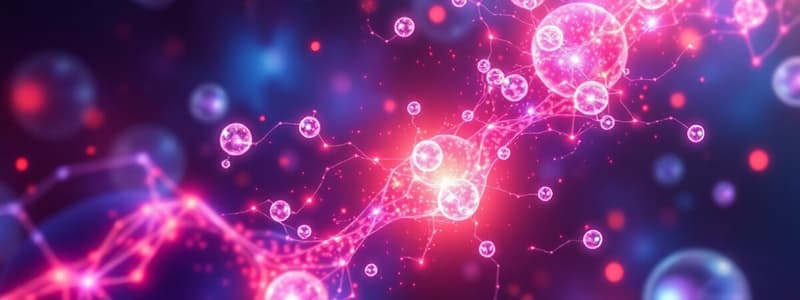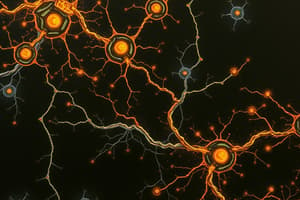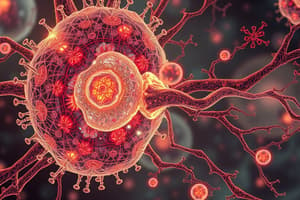Podcast
Questions and Answers
What role does the G protein play in the signaling process described?
What role does the G protein play in the signaling process described?
- It binds to adenylate cyclase. (correct)
- It activates cytoplasmic enzymes directly.
- It converts ATP to cAMP.
- It amplifies the metabolic effects in the cell.
What is the result of adenylate cyclase activity?
What is the result of adenylate cyclase activity?
- Inactivation of kinases.
- Synthesis of guanosine triphosphate (GTP).
- Conversion of ATP to cyclic AMP (cAMP). (correct)
- Direct activation of cytoplasmic enzymes.
What is the primary function of cAMP in the signaling pathway?
What is the primary function of cAMP in the signaling pathway?
- To inhibit enzyme activity.
- To synthesize GTP.
- To directly bind to receptors.
- To activate kinases. (correct)
Which statement best describes the consequence of activating kinases in the cell?
Which statement best describes the consequence of activating kinases in the cell?
What happens to ATP in the signaling pathway when adenylate cyclase is activated?
What happens to ATP in the signaling pathway when adenylate cyclase is activated?
What defines simple diffusion?
What defines simple diffusion?
Which factor does NOT affect the rate of diffusion through a membrane?
Which factor does NOT affect the rate of diffusion through a membrane?
In osmosis, water moves from an area of ___ concentration to an area of ___ concentration.
In osmosis, water moves from an area of ___ concentration to an area of ___ concentration.
What role do solute particles play in the process of osmosis?
What role do solute particles play in the process of osmosis?
Which of the following statements about diffusion is true?
Which of the following statements about diffusion is true?
What energy source does a primary active transport carrier protein use?
What energy source does a primary active transport carrier protein use?
How many sodium ions are expelled from the cell per cycle of the sodium-potassium pump?
How many sodium ions are expelled from the cell per cycle of the sodium-potassium pump?
What effect does the sodium-potassium pump have on K+ and Na+ concentrations within the cell?
What effect does the sodium-potassium pump have on K+ and Na+ concentrations within the cell?
What is one of the main functions of the sodium-potassium pump?
What is one of the main functions of the sodium-potassium pump?
Which transporter relies on the sodium-potassium pump for its operation?
Which transporter relies on the sodium-potassium pump for its operation?
What type of transport is characterized by the movement of solutes through a carrier without direct use of ATP?
What type of transport is characterized by the movement of solutes through a carrier without direct use of ATP?
What does the sodium-glucose transporter (SGLT) primarily transport into the cell?
What does the sodium-glucose transporter (SGLT) primarily transport into the cell?
How much of the daily calories are utilized for the activity of the sodium-potassium pump?
How much of the daily calories are utilized for the activity of the sodium-potassium pump?
Which of the following cell shapes is characterized as being thin and flat?
Which of the following cell shapes is characterized as being thin and flat?
What is the main conclusion of Louis Pasteur's work regarding cell theory?
What is the main conclusion of Louis Pasteur's work regarding cell theory?
Which type of cell is most likely to be described as round to oval?
Which type of cell is most likely to be described as round to oval?
In the study of cytology, who is credited with coining the term 'cellulae'?
In the study of cytology, who is credited with coining the term 'cellulae'?
What is the typical size range for most cells mentioned?
What is the typical size range for most cells mentioned?
Which cell shape is characterized as thread-like?
Which cell shape is characterized as thread-like?
What is the role of aquaporins in osmosis?
What is the role of aquaporins in osmosis?
Which of the following groups of cells is NOT part of the cell theory's principles?
Which of the following groups of cells is NOT part of the cell theory's principles?
Which type of cell has an irregularly angular shape with multiple sides?
Which type of cell has an irregularly angular shape with multiple sides?
What happens to a cell in a hypotonic solution?
What happens to a cell in a hypotonic solution?
How does the osmolarity of 1 M NaCl compare to that of 1 M glucose?
How does the osmolarity of 1 M NaCl compare to that of 1 M glucose?
What is the defining structure for contractile vacuoles in Paramecium?
What is the defining structure for contractile vacuoles in Paramecium?
What is osmotic pressure?
What is osmotic pressure?
Which cell type is typically taller than it is wide?
Which cell type is typically taller than it is wide?
What is indicated by a hypertonic solution concerning cell behavior?
What is indicated by a hypertonic solution concerning cell behavior?
What characterizes an isotonic solution?
What characterizes an isotonic solution?
What is the primary factor that determines tonicity?
What is the primary factor that determines tonicity?
What process is reverse osmosis used for?
What process is reverse osmosis used for?
What type of vesicular transport involves the engulfing of large particles by a cell?
What type of vesicular transport involves the engulfing of large particles by a cell?
What is the function of the rough endoplasmic reticulum?
What is the function of the rough endoplasmic reticulum?
Which of the following organelles is responsible for intracellular digestion?
Which of the following organelles is responsible for intracellular digestion?
What is the main purpose of receptor-mediated endocytosis?
What is the main purpose of receptor-mediated endocytosis?
What are the primary components of the cytoskeleton?
What are the primary components of the cytoskeleton?
Which organelle is known as the 'powerhouse of the cell'?
Which organelle is known as the 'powerhouse of the cell'?
What do peroxisomes primarily utilize molecular oxygen for?
What do peroxisomes primarily utilize molecular oxygen for?
What role do motor proteins dynein and kinesin serve in exocytosis?
What role do motor proteins dynein and kinesin serve in exocytosis?
Which structure forms the basis of the cytosolic network for the organization of cell contents?
Which structure forms the basis of the cytosolic network for the organization of cell contents?
Which of the following best describes transcytosis?
Which of the following best describes transcytosis?
What is autophagy?
What is autophagy?
Which vesicular transport mechanism requires specific binding to receptors?
Which vesicular transport mechanism requires specific binding to receptors?
What do lysosomes primarily contain to aid in digestion?
What do lysosomes primarily contain to aid in digestion?
Flashcards
Cell Theory
Cell Theory
A fundamental theory in biology stating that all living organisms are composed of cells, cells are the basic functional unit of life, and new cells arise from pre-existing cells.
Cell Size
Cell Size
Most cells are microscopic, ranging from 10-15 micrometers in diameter, with a large surface area to volume ratio.
Cell Shape
Cell Shape
Cells have diverse shapes depending on their function. Some examples include squamous (flat), cuboidal (cube-shaped), columnar (tall and narrow), and stellate (star-shaped).
Squamous Cells
Squamous Cells
Signup and view all the flashcards
Cuboidal Cells
Cuboidal Cells
Signup and view all the flashcards
Columnar Cells
Columnar Cells
Signup and view all the flashcards
Polygonal Cells
Polygonal Cells
Signup and view all the flashcards
Stellate Cells
Stellate Cells
Signup and view all the flashcards
Spheroid Cells
Spheroid Cells
Signup and view all the flashcards
Spontaneous Generation
Spontaneous Generation
Signup and view all the flashcards
What are G proteins?
What are G proteins?
Signup and view all the flashcards
What is Adenylate cyclase?
What is Adenylate cyclase?
Signup and view all the flashcards
What is cAMP?
What is cAMP?
Signup and view all the flashcards
What are Kinases?
What are Kinases?
Signup and view all the flashcards
How does a G protein activate adenylate cyclase?
How does a G protein activate adenylate cyclase?
Signup and view all the flashcards
Simple Diffusion
Simple Diffusion
Signup and view all the flashcards
Concentration Gradient
Concentration Gradient
Signup and view all the flashcards
Factors Affecting Diffusion Rate
Factors Affecting Diffusion Rate
Signup and view all the flashcards
Osmosis
Osmosis
Signup and view all the flashcards
Solute's Role in Osmosis
Solute's Role in Osmosis
Signup and view all the flashcards
Aquaporins
Aquaporins
Signup and view all the flashcards
Osmotic Pressure
Osmotic Pressure
Signup and view all the flashcards
Reverse Osmosis
Reverse Osmosis
Signup and view all the flashcards
Osmolarity
Osmolarity
Signup and view all the flashcards
Tonicity
Tonicity
Signup and view all the flashcards
Hypotonic Solution
Hypotonic Solution
Signup and view all the flashcards
Hypertonic Solution
Hypertonic Solution
Signup and view all the flashcards
Primary Active Transport
Primary Active Transport
Signup and view all the flashcards
Sodium-Potassium Pump
Sodium-Potassium Pump
Signup and view all the flashcards
Sodium-Potassium Pump Functions
Sodium-Potassium Pump Functions
Signup and view all the flashcards
Secondary Active Transport
Secondary Active Transport
Signup and view all the flashcards
Sodium-Glucose Transporter (SGLT)
Sodium-Glucose Transporter (SGLT)
Signup and view all the flashcards
SGLT Function in Kidney Cells
SGLT Function in Kidney Cells
Signup and view all the flashcards
Uniport
Uniport
Signup and view all the flashcards
Antiport
Antiport
Signup and view all the flashcards
What is vesicular transport?
What is vesicular transport?
Signup and view all the flashcards
What is endocytosis?
What is endocytosis?
Signup and view all the flashcards
What is phagocytosis?
What is phagocytosis?
Signup and view all the flashcards
What is pinocytosis?
What is pinocytosis?
Signup and view all the flashcards
What is receptor-mediated endocytosis?
What is receptor-mediated endocytosis?
Signup and view all the flashcards
What is exocytosis?
What is exocytosis?
Signup and view all the flashcards
What is the cytoskeleton?
What is the cytoskeleton?
Signup and view all the flashcards
What are the components of the cytoskeleton?
What are the components of the cytoskeleton?
Signup and view all the flashcards
What are microfilaments?
What are microfilaments?
Signup and view all the flashcards
What are intermediate filaments?
What are intermediate filaments?
Signup and view all the flashcards
What are microtubules?
What are microtubules?
Signup and view all the flashcards
What are organelles?
What are organelles?
Signup and view all the flashcards
What is the nucleus?
What is the nucleus?
Signup and view all the flashcards
What is the endoplasmic reticulum (ER)?
What is the endoplasmic reticulum (ER)?
Signup and view all the flashcards
What are ribosomes?
What are ribosomes?
Signup and view all the flashcards
Study Notes
Cell Structure and Function
- Cells are the fundamental units of life.
- Cells exhibit biochemical similarities across species.
- Cells function as structural and functional units in organisms.
Cell Shapes and Sizes
- There are approximately 200 different cell types in the human body.
- Cell shapes vary depending on their locations and function.
- Cells have a range of sizes; most cells have a diameter of 10-15 micrometers (µm).
- Cell size is limited by the ratio of volume to surface area. An increase in volume increases more than surface area.
Cell Theory
- Organisms are composed of cells.
- Cells originate only from preexisting cells.
- Cells exhibit similar compositions and metabolic processes.
- Cell structure and functions are due to the activities of cells.
Microscopes
- Development of light microscopy allowed for identification of organelles within cells.
- Transmission electron microscopes (TEM) and scanning electron microscopes (SEM) improved resolution and revealed details about internal structures and surface features.
The Plasma Membrane
- The plasma membrane defines the boundaries of the cell.
- It's a selectively permeable barrier.
- Plasma membranes have intracellular and extracellular faces.
- The plasma membrane regulates the passage of material into and out of the cell.
- Made up of a bilipid layer.
- Contains proteins and cholesterol.
Membrane Lipids
- Most of the membrane molecules are lipids.
- Phospholipids make up 75% of the membrane lipids.
- Phospholipids have hydrophilic heads that face the outside and hydrophobic tails that face the inside of the membrane.
- Cholesterol molecules are interspersed throughout the phospholipid bilayer, increasing the membrane's solidity.
- Glycolipids are carbohydrate chains attached to phospholipids.
Membrane Proteins
- Membrane proteins make up 50% of the membrane by weight.
- Integral proteins penetrate the membrane completely passing through the membrane.
- Peripheral proteins do not penetrate the membrane.
- Integral proteins have hydrophilic regions facing the fluid inside and outside the cell, and hydrophobic regions passing through the lipid layer.
- Proteins play various roles, including transport, recognition, communication, and binding.
Receptor Protein Function
- Receptors bind specific chemical messengers.
- Enzymes catalyze chemical reactions.
- Channels allow specific substances through the lipid bilayer.
- Cell identity markers distinguish cells from foreign cells.
- Cell adhesion molecules enable cells to bind to one another.
Peripheral Proteins
- Peripheral proteins are bound to one face of the membrane.
- Receptors bind chemical signals
- Second messenger systems communicate within the cell
- Enzymes catalyze reactions of substance digestion and messenger production
- Channel proteins allow substances to pass through
- Some are always open.
- Ligand-gated and voltage-gated channels respond to specific signals.
- Mechanically-gated channels respond to physical stresses.
Transport
- Carriers:bind solute and transfer across membrane
- Uniport:carries one type of solute
- Symport:carries two or more solutes in the same direction
- Antiport:carries two or more solutes in opposite directions
Secondary Active Transport
- Carrier moves solute through membrane indirectly using energy of sodium gradient
Vesicular Transport
- Transport of large particles, molecules, and fluid into the cell (endocytosis) and out of the cell (exocytosis).
- Endocytosis: Phagocytosis, Pinocytosis, Receptor-mediated Endocytosis.
- Exocytosis: Replacement of plasma membrane.
Cytoskeleton
- Cytoskeleton provides internal framework for cell shape and movement.
- It is composed of microfilaments, intermediate fibers, and microtubules.
- Microfilaments: made of actin.
- Intermediate filaments: give cells their shape.
- Microtubules: made of tubulin.
Organelles
- Organelles are the internal structures within a cell performing functions.
- Membranous organelles contain membranes, such as the nucleus.
- Nonmembranous organelles do not contain membranes, such a ribosomes.
Nucleus
- Nucleus: largest organelle- contains DNA (genetic information).
- Nuclear envelope: double membrane that separates the nucleus from the cytoplasm. Nuclear envelope has nuclear pores to regulate molecular traffic.
- Nucleolus: site of rRNA synthesis and ribosome assembly.
- Chromatin: is composed of DNA and protein.
Endoplasmic Reticulum
- Endoplasmic reticulum is a system of channels (cisternae).
- Rough ER: covered with ribosomes and involved in protein synthesis.
- Smooth ER: lacks ribosomes and involved in lipid synthesis and processing of substances including alcohol and drugs.
Ribosomes
- Ribosomes are small granules of protein and RNA.
- Ribosomes are sites of protein synthesis.
- Ribosomes can be found in free cytosol or bound to rough ER.
Golgi Complex
- Modifies, sorts, and packages proteins and lipids produced in the ER.
- Transports proteins to other organelles or to the plasma membrane for secretion.
- Golgi vesicles are small sacs formed off the Golgi complex.
Lysosomes
- Lysosomes are a package of enzymes bound by a membrane.
- They perform intracellular digestion of materials.
Peroxisomes
- Peroxisomes resemble lysosomes but have different enzymes.
- They use molecular oxygen to oxidize organic molecules into water and oxygen.
Proteosomes
- Proteosomes dispose of surplus proteins.
- They contain proteins that break down proteins into shorter peptides and amino acids.
Mitochondria
- Mitochondria are double-membraned organelles.
- They generate energy (ATP) through cellular respiration.
Centrioles
- Centrioles are short cylindrical assemblies of microtubules arranged in nine groups of three microtubules each (9x3).
- Centrioles form basal bodies of cilia and flagella.
- Centrioles play a role in cell division.
Inclusions
- Inclusions are stored cellular products.
- Inclusions can include materials like glycogen, pigments, fat droplets, foreign substances like viruses, or even bacteria.
- Inclusions are not essential for cell survival
Cilia
- Hair-like projections that move substances across the cell surface in one direction.
- Cilia are involved in various cellular activities such as movement, sensory perception, and fluid transport.
- The structure of cilia is a 9 + 2 arrangement containing microtubules and dynein arms.
Flagella
- A tail-like structure that moves the cell.
- The structure of flagella is identical to cilia and uses similar mechanisms for movement.
- Flagella are found on sperm cells, enabling them to propel themselves.
Pseudopods
- Continuously changing extensions of the cell that change in shape and size
- Useful for cellular locomotion and capturing foreign particles.
Studying That Suits You
Use AI to generate personalized quizzes and flashcards to suit your learning preferences.




